Artificial Intelligence (AI) tools have made huge leaps in recent years. A lot of website owners and writers are experimenting with AI content generators. As a result, AI content detectors have also become popular, practically overnight.
The goal of these tools is to help you figure out what content comes from humans and what is machine-generated. In many cases, that’s no longer evident at a quick glance, so these types of tools can offer great value if you want to keep the content you publish AI free.
In this article, we’re going to compare eight of the most popular ⭐ AI content detectors on the market using the same text. We’ll see which detectors fare better and discuss whether they’re worth using. Let’s get to it!
📚 Table of contents:
1. AI Text Classifier

OpenAI became one of the most well-known companies in the world with the launch of ChatGPT 3. The Large Language Model (LLM) is leagues ahead of most AI tools that came before when it comes to generating content, answering questions, creating websites, and solving problems in general.
Since then, OpenAI has gone to launch ChatGPT 4, which is a much improved version. The same company also offers a free tool called AI Text Classifier. This is the first of the AI content detectors we’ll look at. It enables you to determine whether a specific text was created using an AI tool.
To test AI Text Classifier, we used ChatGPT 4 to generate two summaries of random newsworthy events. Here’s part of one of those texts, so you can get a sense for what the tool can do (in case you haven’t used it yet):
The international community has been closely monitoring the recent volcanic eruption on the small island of Montserrat, located in the Caribbean. The eruption occurred at the end of April, forcing thousands of residents to evacuate their homes as lava and ash blanketed the island. Scientists believe that the eruption is a result of increased seismic activity in the region, which has been observed over the past few months. Emergency response teams from neighboring countries, along with international aid organizations, have been working tirelessly to provide support to the affected residents, offering temporary shelter, food, and medical assistance.
This could easily pass as a human-created update about a news event. It’s not the most engaging content, but it’s grammatically sound and easy to understand. In our experience testing AI content generation, that’s already saying a lot.
You can use AI Text Classifier by visiting the tool’s home page and entering the text you want to test. In this case, the tool classified one of our test texts as “Very unlikely to be AI generated”, and the second as “Unlikely to be AI generated”:
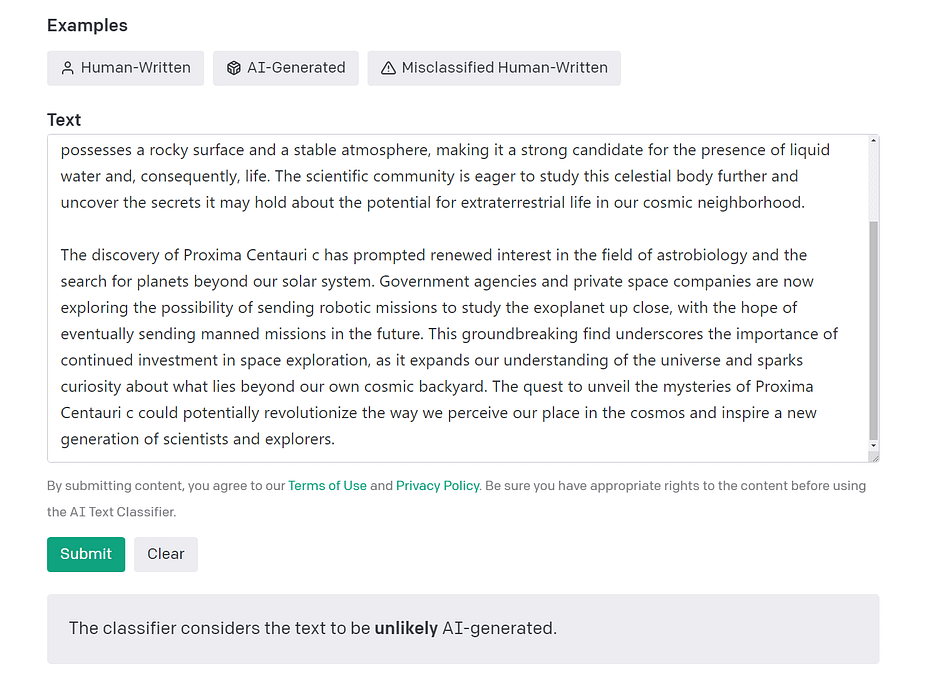
This particular result is surprising, because we’re using an OpenAI tool to check the text that ChatGPT produced. It’s worth noting that we used several examples of texts with different lengths, to give the detector more data to work with.
Does AI Text Classifier work? ⚙️
Our testing showed that OpenAI’s AI Text Classifier doesn’t provide accurate AI detection results. Every text we generated using ChatGPT 4 was tagged as unlikely or very unlikely to be created by an AI.
2. Writer

The Writer app enables you to generate text content and summarize audio files. Along with its content-generation tools, Writer also offers a feature that’s supposed to help you spot content written by AI.
The Writer AI detector is easy to use. You can paste text of up to 1,500 words or enter a URL, and Writer will tell you how likely it is that a human wrote that text. During our test, Writer classified one text as 96% human-generated content, and the other as 83% human-generated:
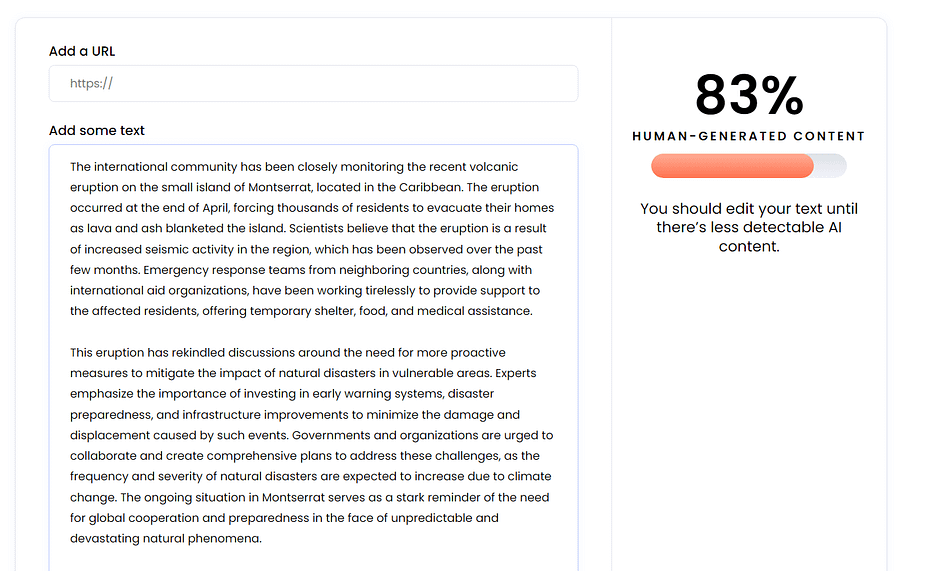
All of the text submitted during both tests was 100% AI generated. The use of percentages makes this tool seem more precise than some of its competitors, but the results speak for themselves. In most cases, Writer is no match for modern content-generation tools such as ChatGPT.
Does Writer work? ⚙️
By and large, Writer can’t detect modern AI generated content. The tool sometimes suggests editing text so that it reads more “human-like”, but it doesn’t provide specific notes on what to modify.
3. Copyleaks
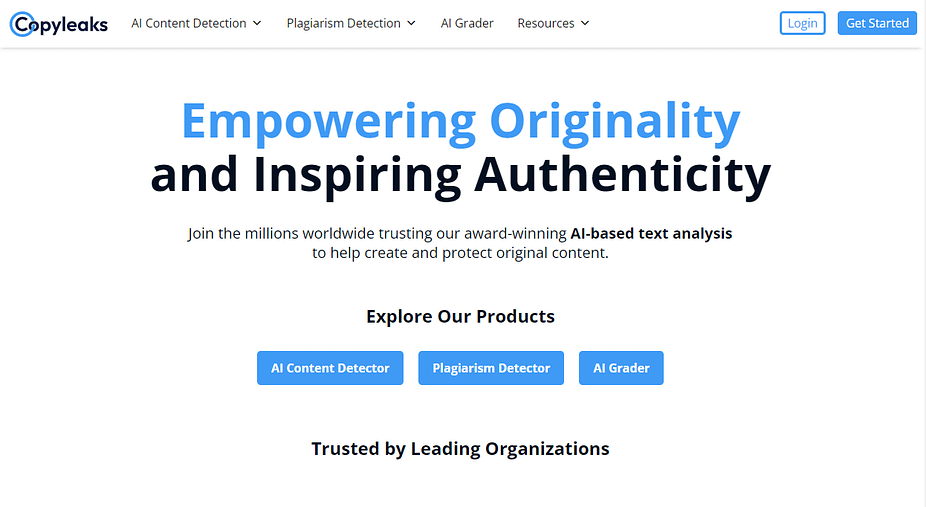
Copyleaks is a company that provides plagiarism detection, grading, and AI content detection tools. The service offers a Chrome extension that enables you to test content anywhere on the web to see if it was generated by AI. It also includes an API integration, so you can use its testing tools directly within your site or whatever platform you’re working with.
In terms of accuracy, Copyleaks’ tool scores fairly high marks. The same AI generated texts that stumped both AI Text Classifier and Writer were earmarked as 92.6% and 82.3% likely to be written by an AI:
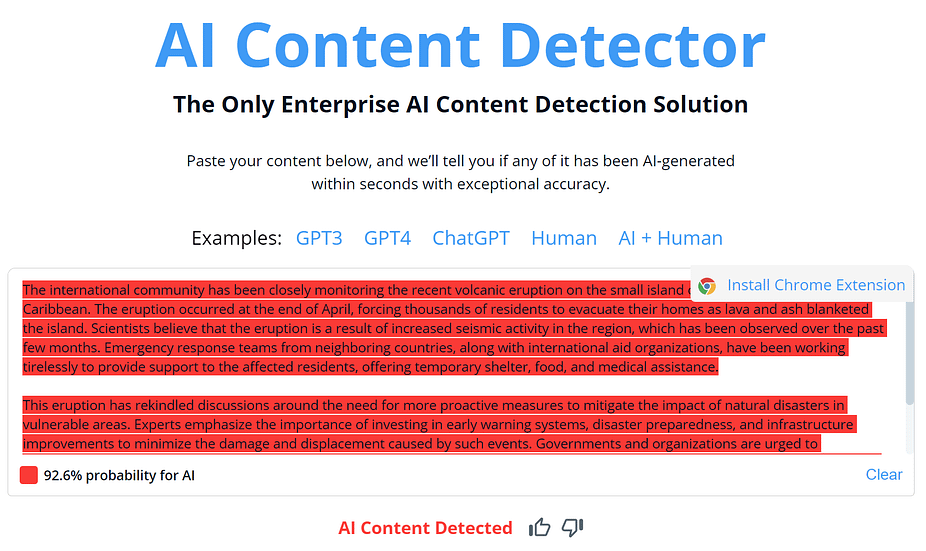
That’s not to say that the Copyleaks AI content detection tool is without problems. During our tests, their AI detector flagged fully human-generated text as “unlikely to be written by a human”.
One upside is that this tool lets you manually mark its results as accurate or inaccurate. If the developers use that information to improve its accuracy, Copyleaks may become more effective over time.
Does Copyleaks work? ⚙️
Copyleaks is mostly accurate when it comes to detecting AI content. It’s not fully accurate, but every text we created using ChatGPT was flagged as mostly AI written.
4. GPTZero
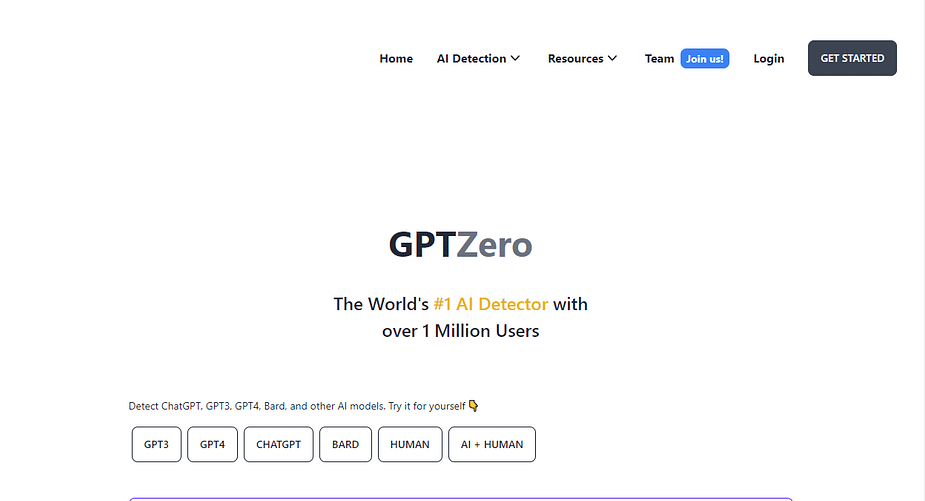
GPTZero is perhaps the most popular option among AI content detectors at the moment. It was built as a response to ChatGPT, and it scores the text you submit on both “perplexity” and “burstiness”. Perplexity measures the randomness of the words used, whereas burstiness measures the variation in perplexity.
Humans tend to write in a way that is much more random than an AI or LLM, which is to be expected. During our tests, GPTZero correctly assessed that both texts were created entirely using AI:
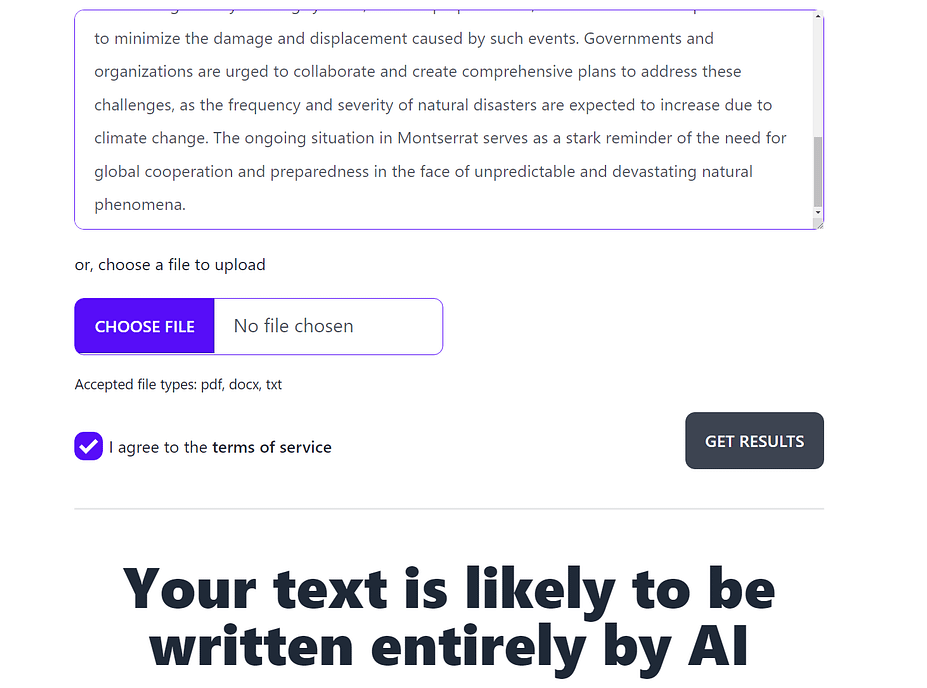
GPTZero also highlights specific phrases it thinks are more likely to be written by an AI. To be fair, the tool does return false results sometimes. For example, it flagged part of the American Declaration of Independence as AI generated during our tests.
Despite that, GPTZero gives generally accurate results, and it’s the only tool we’ve checked so far that warns you it can return false positives. This is essential information because as AI content generation continues to improve, AI content detectors will struggle more and more to catch up and return accurate assessments.
Does GPTZero work? ⚙️
GPTZero does a great job of detecting content created by ChatGPT. It also warns users that they shouldn’t blindly trust AI content detectors, which makes it an easy recommendation.
5. Content at Scale
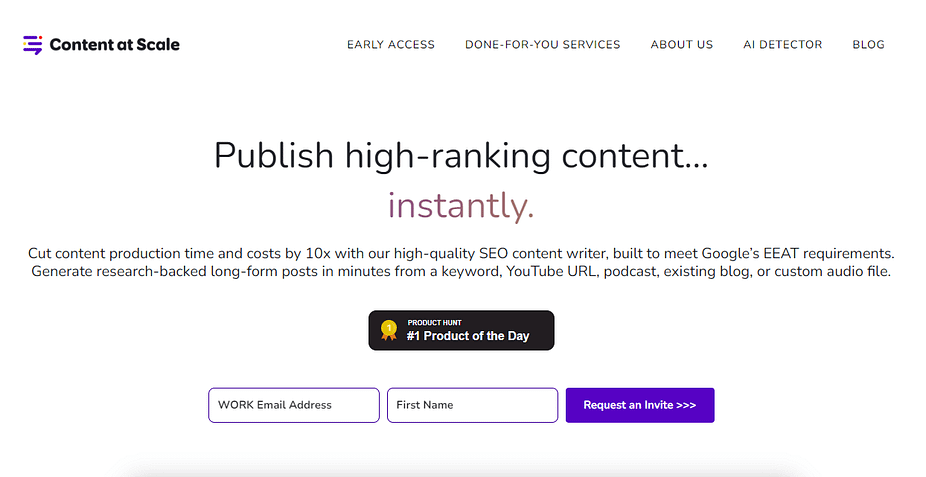
Content at Scale markets itself as an AI assisted writing tool that takes Search Engine Optimization (SEO) into account. However, we’re not here to test its content-generation capabilities today.
On top of its core service, Content at Scale offers a free tool that checks for AI generated content. During our tests, it flagged both examples as highly likely to be AI generated:
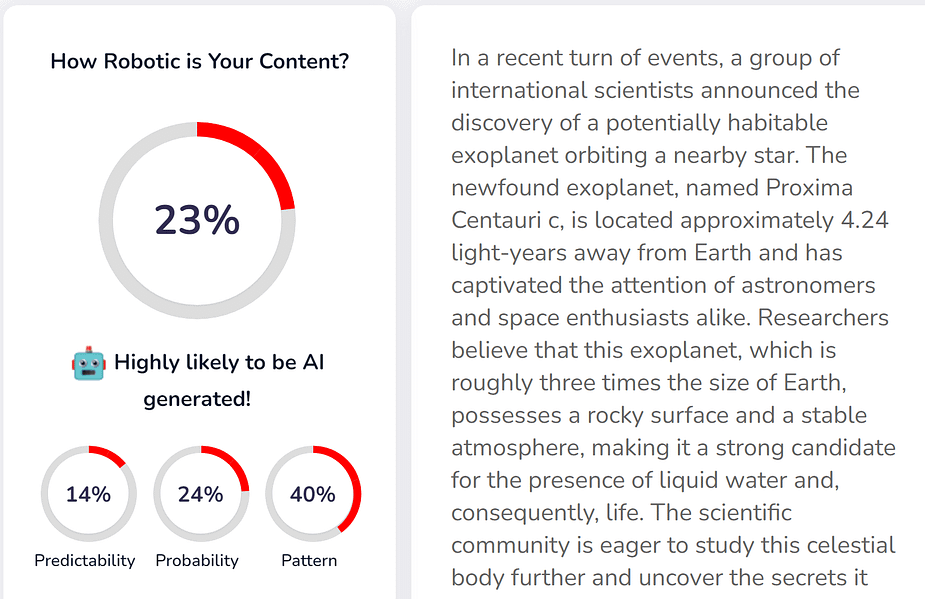
Content at Scale measures text using multiple metrics, including how predictable the word choice is and whether it follows “known” patterns. This is similar to the model GPTZero uses, only with a different algorithm.
This AI content detector also flags specific paragraphs and phrases if it’s possible they might be AI generated. In theory, this might help you spot AI assisted writing. However, during our tests, the AI detector also flagged part of the American Declaration of Independence as written by an AI (which we’re pretty confident it’s not 😅).
Does Content at Scale work? ⚙️
Content at Scale is fairly accurate at detecting AI generated text. It scores texts on several metrics (although it doesn’t explain what those metrics measure), and it flags specific paragraphs and sentences if it deems them “suspicious”. Despite the overall positive results, however, some of its flags can be inaccurate.
6. Sapling
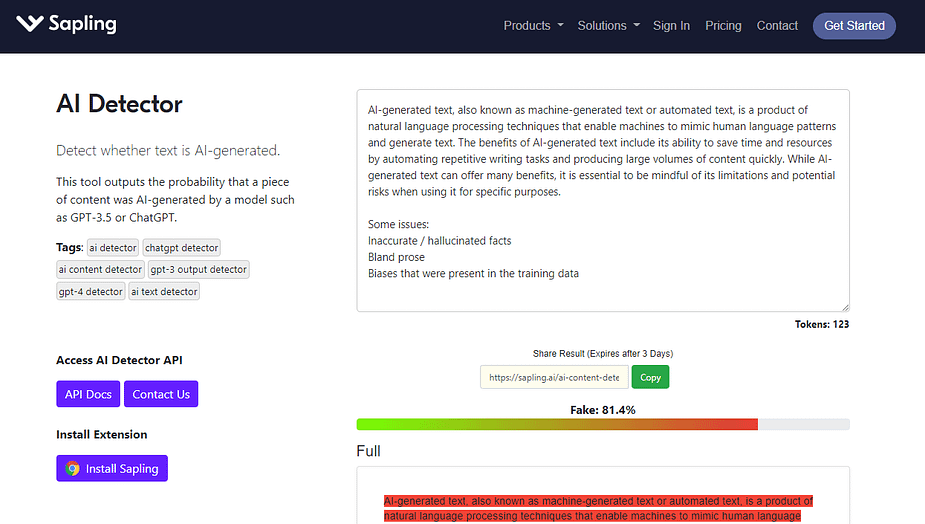
Sapling offers a suite of autocomplete tools for websites, as well as grammar correction products. One of its offerings is an AI content detector with both free and premium plans. The free option doesn’t require you to sign up for an account, but it does limit the length of the text you can check.
The tool itself is trained to detect text created with the most recent GPT models. During our tests, it returned “Fake” scores of 100% and 98.8%:
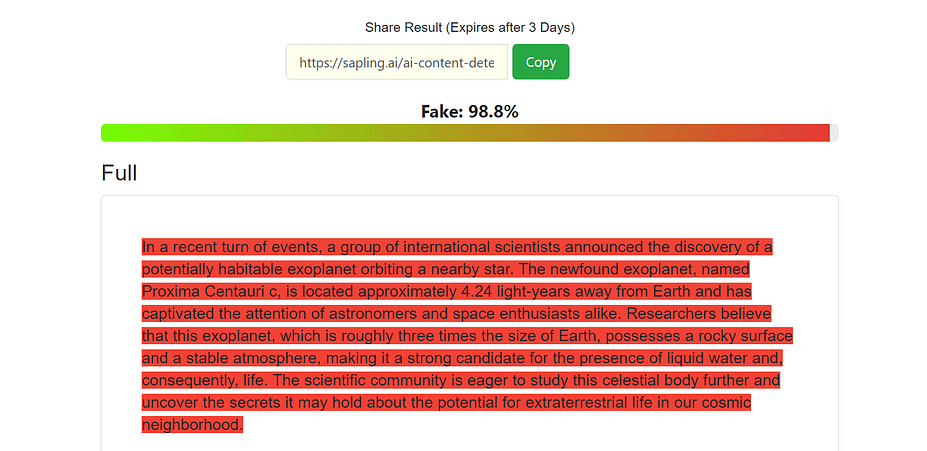
These results are incredibly accurate considering that both texts are fully AI generated, with no alterations. Sapling also provides a breakdown of the results, and highlights the parts of the text it thinks were created by an AI.
Sapling offers a free extension that you can use to test snippets of text anywhere on the web. This service also provides API access with its premium plans, which you can use to automate testing.
Does Sapling work? ⚙️
Sapling performed almost perfectly during testing. The only downside of this service is that it limits the length of the text you can test, at least on the free version. However, it’s far from the only platform to do this, and the free version doesn’t require you to sign up for an account.
7. Crossplag

Crossplag offers plagiarism detection tools for small businesses and educational institutions. It also provides a free tool you can use on its website to check for AI written content. This tool takes text and gives you a percentage indicating how likely it is to be AI generated.
During our test, Crossplag flagged one of the examples as 84% likely to be AI. However, the second example returned 4%. That translates to a result of “This text is mainly written by a human”:
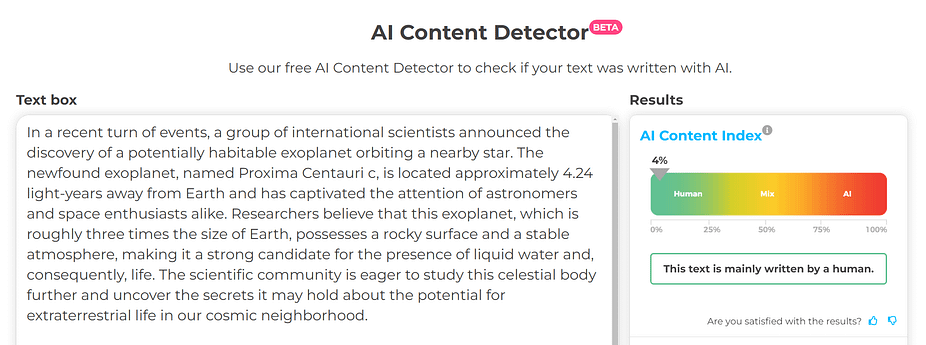
To further test Crossplag, we turned once more to the American Declaration of Independence. The tool flagged part of its text as 50% written by an AI.
Finally, it’s worth noting that Crossplag limits the amount of text you can test without an account. During our experiments, we could only run two tests before we were forced to sign up for a free account.
Does Crossplag work? ⚙️
Based on our tests, Crossplag can sometimes detect AI generated text accurately. However, it consistently returns inaccurate results with both AI generated and fully-human text.
8. ZeroGPT
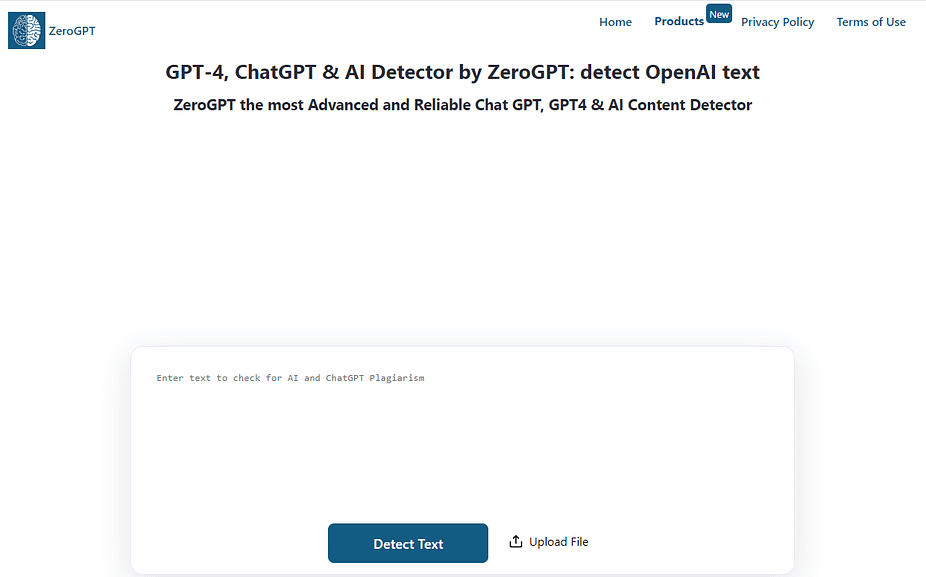
Despite the similar name, ZeroGPT is a completely different tool from GPTZero. This is a free AI detection service from a company that offers other products in the AI space, including one that lets you talk to ChatGPT through WhatsApp or Telegram.
When we tested this final option on our list of AI content detectors, our two ChatGPT-generated snippets were flagged as 100% created by AI:
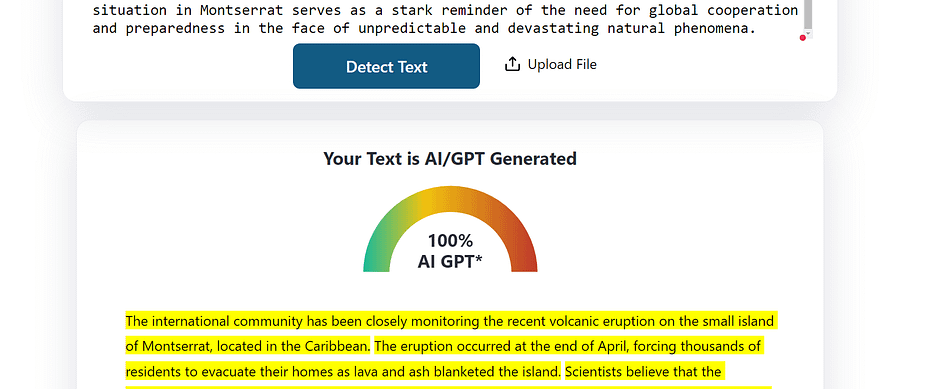
Despite its initial accuracy, this tool sometimes falsely flags regular human content as generated by AI. Once more, the Declaration of Independence tripped it up, scoring a result of 68.1% AI generated.
Does ZeroGPT work? ⚙️
Generally speaking, ZeroGPT can accurately detect AI generated text. However, it also flags human-generated content regularly, and can give it a high percentage of being created by an AI. This makes it difficult to trust the results in general.
Conclusion 🧐
AI content detectors are fighting an uphill battle. As tools such as ChatGPT continue to improve, these services need to adapt and figure out better ways to detect whether text was generated by an AI or not.
It’s important to understand that most AI content detectors aren’t wholly accurate, and may return false positives often. Having said that, GPTZero and Copyleaks were the most accurate tools we tested when it came to detecting fully AI generated content (created using ChatGPT). If you have to use an AI detector, we’d recommend using one of those two (or both to improve your chances of reliable results).
💡 Enjoyed this article? Then definitely check out our roundup of the best AI tools to help you build a website and our review of the best ChatGPT plugins.
Do you have any questions about AI content detectors? Let’s talk about them in the comments section below!
.png)
Post a Comment